Ash Mint Slipover |
||||||||||||||||
 |
 |
|||||||||||||||
Knitted vest / slipover in DROPS Sky and DROPS Kid-Silk. Piece is knitted with V-neck pattern, vents in the sides, textured pattern and displacements. Size XS – XXL.
DROPS 227-31 |
||||||||||||||||
|
---------------------------------------------------------- EXPLANATION FOR THE PATTERN: ---------------------------------------------------------- GARTER STITCH (back and forth): Knit all rows. 1 ridge vertically = knit 2 rows. PATTERN: See diagrams A.1 to A.5. Diagrams show all rows in pattern seen from the right side. DECREASE TIP: All decreases are done from the right side! Work 6 stitches in garter stitch, slip 1 stitch knitwise, knit 1, pass slipped stitch over stitch worked(= 1 stitch decreased), work until 8 stitches remain, knit 2 together(= 1 stitch decreased), work 6 stitches in garter stitch. ---------------------------------------------------------- START THE PIECE HERE: ---------------------------------------------------------- VEST – SHORT OVERVIEW OF THE PIECE: Work back piece and front piece back and forth on circular needle. Then assemble the vest by sewing it together on the shoulders and down the side seams. Finish with a neck edge in round on a circular needle. BACK PIECE: Cast on 73-77-85-89-97-105 stitches on circular needle size 4.5 mm with 1 strand of each colour (= 2 strands). Purl 1 row from wrong side. Then work rib as follows: 6 stitches in GARTER STITCH - read explanation above - * knit 1/purl 1 *, repeat from *-* until 7 stitches remain, knit 1 and 6 stitches in garter stitch. Continue rib back and forth like this for 4 cm. Switch to circular needle size 5.5 mm. Now work pattern as follows: 6 stitches in garter stitch, work A.1 (= 2 stitches) until 7 stitches remain, work first stitch in A.1, 6 stitches in garter stitch. REMEMBER THE KNITTING TENSION! Continue back and forth like this until piece measures 29-30-31-32-33-34 cm. Now work in garter stitch over the outermost 8-8-10-10-10-10 stitches in each side. When 2 ridges have been worked over these stitches, cast off 2-2-4-4-4-4 stitches for armholes at the beginning of the next 2 rows = 69-73-77-81-89-97 stitches. In sizes XS, S, M and L skip next section and continue to work from ALL SIZES – read explanation below. In sizes XL and XXL work as explained below. SIZE XL AND XXL: Now decrease 1 stitch inside 6 stitches in garter stitch in each side- read DECREASE TIP. Decrease like this on every row from right side 4-6 times in total = 81-85 stitches. ALL SIZES: Continue back and forth with A.1 and 6 stitches in garter stitch in each side. When piece measures 56-58-60-62-64-66 cm, cast off the middle 19-19-19-23-23-23 stitches for neck and finish each shoulder separately. Then cast off 1 stitch on next row from the neck = 24-26-28-28-28-30 stitches remain for shoulder. When piece measures 58-60-62-64-66-68 cm, cast off with knit over knit and garter stitch over garter stitch. Work the other shoulder the same way. FRONT PIECE: Cast on 73-77-85-89-97-105 stitches on circular needle size 4.5 mm with 1 strand of each colour (= 2 strands). Purl 1 row from wrong side. Then work rib as follows: 6 stitches in garter stitch, * knit 1, purl 1 *, work from *-* until 7 stitches remain, knit 1, 6 stitches in garter stitch. Continue back and forth like this for 4 cm. Switch to circular needle size 5.5 mm. Now work pattern as follows: 6 stitches in garter stitch, work A.1 (= 2 stitches) until 7 stitches remain, work first stitch in A.1, 6 stitches in garter stitch. Continue back and forth like this. When piece measures 9-9-10-10-11-11 cm, work pattern as follows: Work 6 stitches in garter stitch, A.1 as before over the next 5-7-11-13-17-21 stitches, A.2 over the next 22 stitches, A.1 as before over the next 7 stitches (the middle of these 7 stitches is middle stitch on front piece = a knit stitch), A.3 over the next 22 stitches, A.1 as before over the next 5-7-11-13-17-21 stitches, 6 stitches in garter stitch. Continue back and forth like this until piece measures 29-30-31-32-33-34 cm. Now work in garter stitch over the outermost 8-8-10-10-10-10 stitches in each side. When 2 ridges have been worked over these stitches, cast off 2-2-4-4-4-4 stitches for armholes at the beginning of the next 2 rows = 69-73-77-81-89-97 stitches. OVERVIEW OF NEXT SECTION: Then work as explained below in the next sections - choose section for your size. SIZE XS, S, M and L: Divide the piece for right and left front piece, at the same time work pattern and decrease for V-neck as explained below. PATTERN AND DECREASE FOR V-NECK: Continue to work with 6 stitches in garter stitch towards the side and pattern as before over the remaining stitches. When A.2 and A.3 have been worked vertically 2 times in total, work A.4 over A.2 and A.5 over A.3 (continue the remaining stitches as before). Decrease in A.4 and A.5 is decrease for V-neck. When A.4 and A.5 have been worked vertically, continue decrease the same way until 10-10-10-12 stitches have been decreased in total (on each front piece). DIVISION FOR RIGHT AND LEFT FRONT PIECE: When piece measures 37-38-39-40 cm, divide the piece for right and left front piece by slipping middle stitch and the stitches for the other side of front piece on a thread (middle stitch = 1 knit stitch). Then work each shoulder separately with pattern and decrease as explained above (divide the piece before all decreases in pattern are done). When all decreases for V-neck are done, 24-26-28-28 stitches remain for shoulder. Continue to work until piece measures 58-60-62-64 cm. Cast off with knit over knit and purl over purl. Work the other shoulder the same way. SIZE XL AND XXL: Decrease stitches for armhole, at the same time divide the piece for right and left front piece, and work pattern and decrease for V-neck as explained below. DECREASE FOR ARMHOLES: Now decrease 1 stitch inside 6 stitches in garter stitch in each side the same way as on back piece - remember DECREASE TIP. Decrease like this on every row from right side 4-6 times in total = 81-85 stitches. PATTERN AND DECREASE FOR V-NECK: After last decrease for armhole continue to work with 6 stitches in garter stitch towards the side and pattern as before over the remaining stitches. When A.2 and A.3 have been worked vertically 2 times in total, work A.4 over A.2 and A.5 over A.3 (continue the remaining stitches as before). Decrease in A.4 and A.5 is decrease for V-neck. When A.4 and A.5 have been worked vertically, continue decrease the same way until 12-12 stitches have been decreased in total (on each front piece). DIVISION FOR RIGHT AND LEFT FRONT PIECE: When piece measures 41-42 cm, divide the piece for right and left front piece by slipping middle stitch and the stitches for the other side of front piece on a thread (middle stitch = 1 knit stitch). Then work each shoulder separately with pattern and decrease as explained above (divide the piece before all decreases are done). When all decreases for V-neck are done, 28-30 stitches remain for shoulder. Work until piece measures 66-68 cm. Cast off with knit over knit and purl over purl. Work the other shoulder the same way. ASSEMBLY: Sew shoulder seams inside cast-off edges. Sew side seam in outermost loop of edge stitches from armhole and down until approx. 17 cm remain (= vent). Repeat in the other side. NECK EDGE: Begin at one shoulder seam and pick up from right side approx. 106 to 130 stitches inside 1 edge stitch in garter stitch around the neck on a short circular needle size 4.5 mm with 1 strand in each quality (= 2 strands). Work rib in the round (= knit 1/purl 1) - but adjust so that middle stitch at the front is knitted and that rib fits the entire round. Insert 1 marker in middle stitch at the front. AT THE SAME TIME on every round decrease 2 stitches mid front as follows: Work until 1 stitch remains before stitch with marker, slip the next 2 stitches knitwise, knit 1, pass the 2 slipped stitches over stitch worked (= 2 stitches decreased). When decreasing like this the knit stitch in the middle of V-neck will follow as a straight line mid front. Decrease like this every round until neck edge measures approx. 3 cm in knitting direction. Cast off stitches with knit over knit and purl over purl. |
||||||||||||||||
Diagram explanations |
||||||||||||||||
|
||||||||||||||||
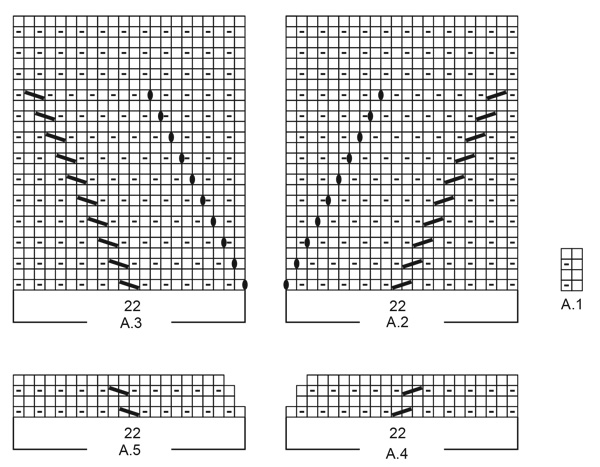
|
||||||||||||||||

|
||||||||||||||||
|
Have you made this or any other of our designs? Tag your pictures in social media with #dropsdesign so we can see them! Do you need help with this pattern?You'll find tutorial videos, a Comments/Questions area and more by visiting the pattern on garnstudio.com. © 1982-2024 DROPS Design A/S. We reserve all rights. This document, including all its sub-sections, has copyrights. Read more about what you can do with our patterns at the bottom of each pattern on our site. |
||||||||||||||||







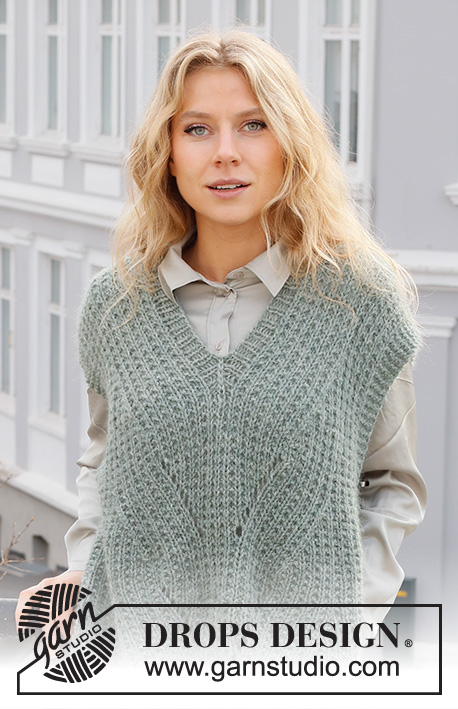
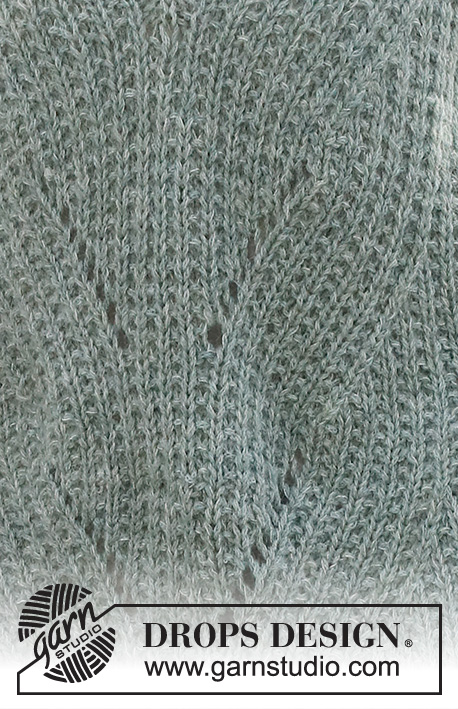

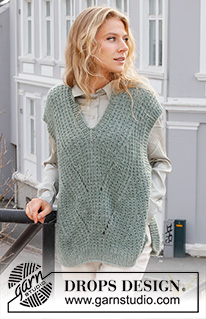














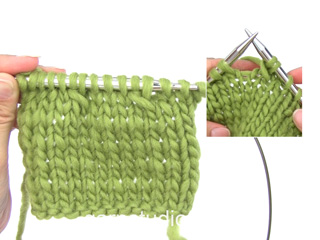



































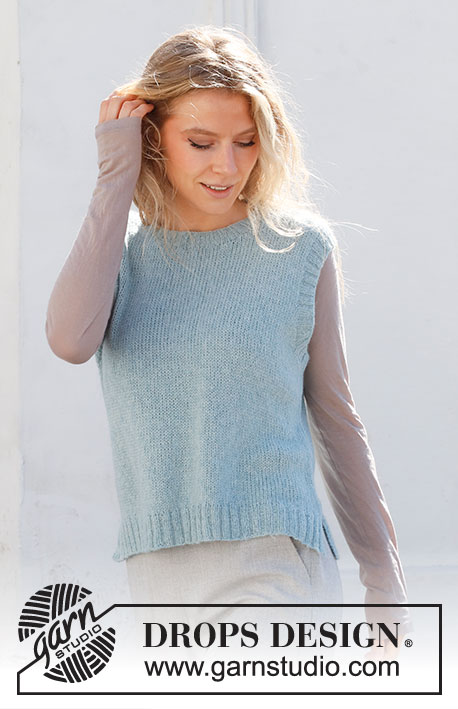






Comments / Questions (31)
Hei Jeg går ut fra at de rette maskene i mønster A1 skal strikkes på retten, dvs man starter på A1 fra vrangen? (Ellers skulle jeg også ønske at spørsmålene som var stilt på andre språk kunne enkelt oversettes.)
29.01.2024 - 20:01DROPS Design answered:
Hei Ulla, Om du begynner mønster A.1 fra retten eller vrangen begynner du med 1 rett, deretter 1 vrang. Det spiller ingen rolle. Men hvis du helst vil begynne fra retten avslutter du vrangbord etter en pinne fra vrangen. God fornøyelse!
30.01.2024 - 06:43Hallo Zusammen, leider komme ich beim Vorderteil nicht mit den Maschen zurecht. Laut Anleitung wird die Arbeit erst später geteilt. Nach dem stricken von A.2 und A.3 geht es mit A.4 und A.5 weiter. Wenn ich 6 Maschen kraus rechts, 13 Maschen A 1 und dann A.4 + A.5 stricke komme ich auf 82 Maschen -statt 18 Maschen. Was mache ich falsch?
07.01.2024 - 21:42DROPS Design answered:
Liebe Sibylle, meinen Sie 81 anstatt 18? In XL stricken Sie: 6 M kraus rechts, 13 M A.1, 22 M A.2, 7 M A.1, 22 M A.3, 13 M A.1, 6 M krausrechts = 6+13+22+7+22+13+6=89 Maschen, dann werden 4 Maschen am Anfang der 2 nächsten Reihen abgekettet = 89-8=81 M. Wie zuvor, mit 6 Maschen kraus rechts beidseitig weiterstricken. Die Maschenanzahl wird dann später abnehmen, wenn man A.4 und A.5 strickt. Viel Spaß beim stricken!
08.01.2024 - 10:44Bonjour! Pour m'assurer que je comprend bien le patron, pour le devant: quand on a tricoté 2 fois A2 et A4, on fait A3 et A5 qui correspondent aux diminutions donc à la pointe de l'encolure en V, n'est-ce pas? Ce qui devrait arriver à environ 39 cm du bas?
26.11.2023 - 22:16DROPS Design answered:
Bonjour Mme Carrier, en taille M, après les emmanchures et après avoir tricoté 2 x A.2 et A.3 en hauteur, on va tricoter A.4 et A.5, et, répéter ces diminutions 10 fois au total (5 fois les diagrammes A.4/A.5 en hauteur), en même temps, à 39 cm, divisez l'ouvrage au milieu pour terminer chaque devant séparément. Il doit vous rester 28 mailles pour l'épaule quand les diminutions sont terminées. Bon tricot!
27.11.2023 - 10:12Er i gang med forstykket. Efter 2xstrik af A2og A3 kan jeg ikke komme videre. Skal jeg fortsætte med A5&A6 1 gang og hvad med de midterste 7 masker? Skal jeg samtidigt strikke 10 retmasker i hver side inden indtagning til ærmegab? Skal der tages ind til hals samtidigt med indtagning til ærmegab? Mvh
03.11.2023 - 08:29DROPS Design answered:
Hej Dorte, A.4 og A.5 er indtagningerne til V-hals og du tager ind på hver.2pind til du har taget 10 masker ind på hvert forstykke. Se også måleskitsen nederst i opskriften, her kan du også se hvornår du skal lukke af til ærmegab :)
09.11.2023 - 14:54Melody?
08.08.2023 - 00:17Bonjour, je ne comprends pas le principe du diagramme A1. Je fini par 1 rang endroit et un rang envers. Merci de m apporter plus d explications, En vous remerciant Cordialement Catherine Martin
18.01.2023 - 18:00DROPS Design answered:
Bonjour Mme Martin, le diagramme A.1 se tricote ainsi, en commençant sur l'endroit: rang 1 (et- tous les rangs impairs): 1 m end, 1 m env; rang 2 (et tous les rangs pairs: 2 m env. Vous alternez ainsi 1 m jersey (1ère maille de A.1) et 1 m point mousse (2ème m de A.1, que l'on tricote à l'envers tous les rangs). Bon tricot!
19.01.2023 - 10:09Bonjour! Je voudrai savoir comment faire pour tricoter avec des aiguilles droites et combien de mailles faut-il mettre pour le devant et pour le dos dans la taille xl. Merci
28.12.2022 - 10:06DROPS Design answered:
Bonjour Alexandra, seul le col se tricote ici en rond, autrement dit, on utilise une aiguille circulaire pour tricoter le devant et le dos (séparément) pour avoir suffisamment de place pour loger toutes les mailles, vous pouvez ainsi utiliser des aiguilles droites pour le devant /le dos, mais le col devra être tricoté en rond. Bon tricot!
02.01.2023 - 11:06Bonjour Je souhaite réaliser ce modèle, pouvez-vous m’indiquer le nombre de pelote qu’il faut acheter pour une taille L ? Merci
05.10.2022 - 22:49DROPS Design answered:
Bonjour Estelle, vous trouverez les fournitures nécessaires dans l'en-tête et la quantité de laine, au poids pour chaque taille, en même temps que les aiguilles et l'échantillon, ainsi, en taille L, il va vous falloir 200 g DROPS Sky/50 g la pelote = 4 pelotes + 75 g DROPS Kid-Silk/25 g la pelote = 3 pelotes. Bon tricot!
06.10.2022 - 08:25Good day, I can't understand how to continue A4 and A5 after 4 sts have been cast off for the armholes (size S). Now I have 73 sts instead of 77. There will not be enough sts for the pattern if I continue the remaining sts as before (6 sts in garter st, 7 sts A1, 22 sts A4, 7 sts A1, 22 sts A5 etc..). Thank you for the help.
02.10.2022 - 20:22DROPS Design answered:
Dear Alena, after casting off 4 stitches, you work 1 less repeat of A.1 on each side. Happy knitting!
03.10.2022 - 00:33Buonasera, posso utilizzare solo il filato Sky omettendo il Kid silk?
30.08.2022 - 18:48DROPS Design answered:
Buonasera Adelina, può lavorare il modello con il solo filato Sky, tenendo conto che il risultato e il campione risulteranno diversi rispetto a quelli indicati nel modello. Buon lavoro!
31.08.2022 - 09:44